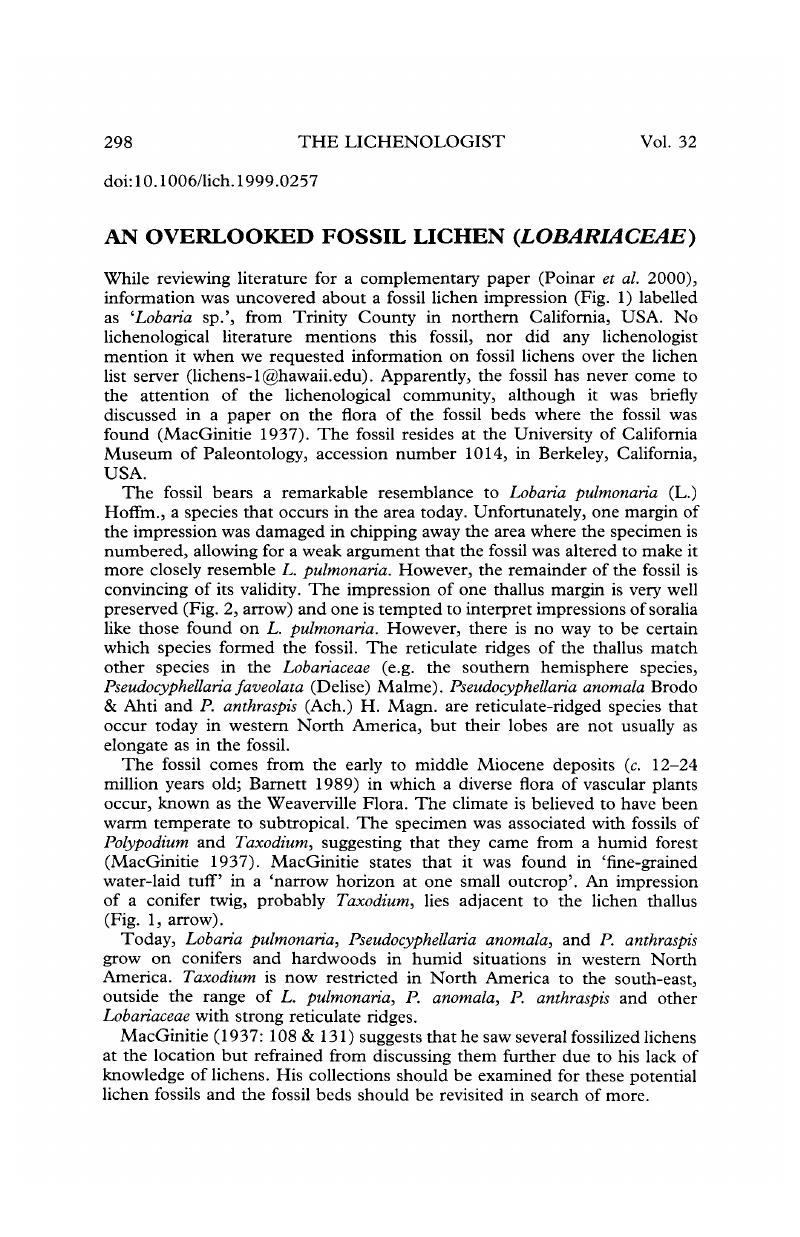Crossref Citations
This article has been cited by the following publications. This list is generated based on data provided by Crossref.
Printzen, Christian
and
Lumbsch, H.Thorsten
2000.
Molecular Evidence for the Diversification of Extant Lichens in the Late Cretaceous and Tertiary.
Molecular Phylogenetics and Evolution,
Vol. 17,
Issue. 3,
p.
379.
Esslinger, Theodore L.
2000.
Recent Literature on Lichens—179*.
The Bryologist,
Vol. 103,
Issue. 4,
p.
816.
Rikkinen, Jouko
2003.
Calicioid lichens from European Tertiary amber.
Mycologia,
Vol. 95,
Issue. 6,
p.
1032.
Printzen, C.
Ekman, S.
and
Tønsberg, T.
2003.
Phylogeography of Cavernularia hultenii: evidence of slow genetic drift in a widely disjunct lichen.
Molecular Ecology,
Vol. 12,
Issue. 6,
p.
1473.
Rikkinen, Jouko
2003.
Cyanobacteria in Symbiosis.
p.
31.
Wang, Xin
Krings, Michael
and
Taylor, Thomas N.
2010.
A thalloid organism with possible lichen affinity from the Jurassic of northeastern China.
Review of Palaeobotany and Palynology,
Vol. 162,
Issue. 4,
p.
591.
Biazrov, L. G.
2013.
Range formulas of lichenized fungi of the family Umbilicariaceae from Mongolia on the base of the world terrestrial ecoregions map.
Novosti sistematiki nizshikh rastenii,
Vol. 47,
Issue. ,
p.
179.
Matsunaga, Kelly K. S.
Stockey, Ruth A.
and
Tomescu, Alexandru M. F.
2013.
Honeggeriella complexa gen. et sp. nov., a heteromerous lichen from the Lower Cretaceous of Vancouver Island (British Columbia, Canada).
American Journal of Botany,
Vol. 100,
Issue. 2,
p.
450.
Prieto, María
Wedin, Mats
and
Ho, Simon
2013.
Dating the Diversification of the Major Lineages of Ascomycota (Fungi).
PLoS ONE,
Vol. 8,
Issue. 6,
p.
e65576.
Lipnicki, Ludwik I.
2015.
The role of symbiosis in the transition of some eukaryotes from aquatic to terrestrial environments.
Symbiosis,
Vol. 65,
Issue. 2,
p.
39.
Hartl, C.
Schmidt, A. R.
Heinrichs, J.
Seyfullah, L. J.
Schäfer, N.
Gröhn, C.
Rikkinen, J.
and
Kaasalainen, U.
2015.
Lichen preservation in amber: morphology, ultrastructure, chemofossils, and taphonomic alteration.
Fossil Record,
Vol. 18,
Issue. 2,
p.
127.
Taylor, Thomas N.
Krings, Michael
and
Taylor, Edith L.
2015.
Systematics and Evolution.
p.
259.
2015.
Fossil Fungi.
p.
297.
Hawksworth, David L.
2015.
Recent Advances in Lichenology.
p.
1.
Tomescu, Alexandru M. F.
Klymiuk, Ashley A.
Matsunaga, Kelly K. S.
Bippus, Alexander C.
and
Shelton, Glenn W. K.
2016.
Their World: A Diversity of Microbial Environments.
Vol. 1,
Issue. ,
p.
69.
Kukwa, Martin
and
Kolanowska, Marta
2016.
Glacial refugia and the prediction of future habitat coverage of the South American lichen species Ochrolechia austroamericana.
Scientific Reports,
Vol. 6,
Issue. 1,
Pankratov, T. A.
Kachalkin, A. V.
Korchikov, E. S.
and
Dobrovol’skaya, T. G.
2017.
Microbial communities of lichens.
Microbiology,
Vol. 86,
Issue. 3,
p.
293.
Kaasalainen, Ulla
Schmidt, Alexander R.
and
Rikkinen, Jouko
2017.
Diversity and ecological adaptations in Palaeogene lichens.
Nature Plants,
Vol. 3,
Issue. 5,
LÜCKING, Robert
MONCADA, Bibiana
and
SMITH, Clifford W.
2017.
The genusLobariella(Ascomycota:Lobariaceae) in Hawaii: late colonization, high inferred endemism and three new species resulting from “micro-radiation”.
The Lichenologist,
Vol. 49,
Issue. 6,
p.
673.
Lücking, Robert
and
Nelsen, Matthew P.
2018.
Transformative Paleobotany.
p.
551.



